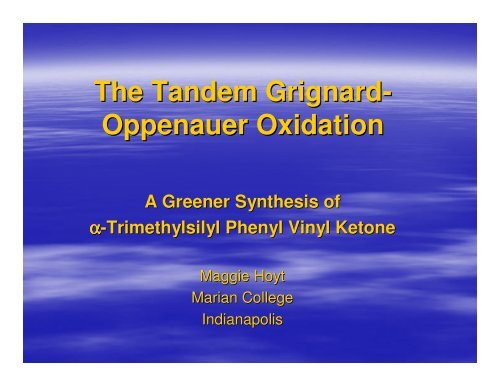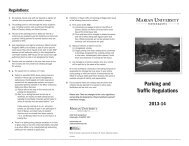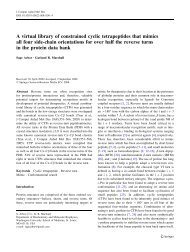The Tandem Grignard- Oppenauer Oxidation
The Tandem Grignard- Oppenauer Oxidation
The Tandem Grignard- Oppenauer Oxidation
You also want an ePaper? Increase the reach of your titles
YUMPU automatically turns print PDFs into web optimized ePapers that Google loves.
<strong>The</strong> <strong>Tandem</strong> <strong>Grignard</strong>- <strong>Grignard</strong><br />
<strong>Oppenauer</strong> <strong>Oxidation</strong><br />
A Greener Synthesis of<br />
α-Trimethylsilyl Trimethylsilyl Phenyl Vinyl Ketone<br />
Maggie Hoyt<br />
Marian College<br />
Indianapolis
Outline<br />
�� Introduction to green chemistry<br />
�� Baylis-Hillman Baylis Hillman reaction<br />
�� My research<br />
�� Continuing research
What is Green Chemistry?<br />
“<strong>The</strong> <strong>The</strong> utilization of a set of principles that reduces or<br />
eliminates the use or generation of hazardous<br />
substance in the design, manufacture and<br />
application of chemical products.” products.<br />
– Doxsee, K.M. and Hutchison, J.E. Green Chemistry: Strategies, Tools, and<br />
Laboratory Experiments. Thomson, Brookes, and Cole. 2003.
Green Chemistry is:<br />
�� An emerging field within organic<br />
chemistry<br />
�� Pollution prevention at the most<br />
fundamental level, atoms and molecules<br />
�� Focuses on reducing intrinsic hazards of<br />
reactions and making them more efficient
Applying Green Chemistry to<br />
Undergraduate Research<br />
�� Assess reactions for the “greenness greenness” of<br />
the reaction<br />
�� Propose safer methods or chemicals that<br />
could be used<br />
�� Implement proposed changes in lab to<br />
determine effectiveness<br />
�� Development of new methodology
O<br />
OR<br />
Baylis-Hillman<br />
Baylis Hillman Reaction<br />
R 3 N<br />
O -<br />
RCHO<br />
O<br />
H - R3N OR R OR<br />
+ NR3<br />
O -<br />
+ NR3<br />
OH<br />
O<br />
R OR<br />
Utility of Baylis-Hillman Adduct<br />
• Densely functionalized<br />
• Broad use as substrate in other reactions
How “Green Green” is the Baylis- Baylis<br />
Hillman Reaction?<br />
�� Mild reaction conditions<br />
�� Very little waste formed<br />
�� Atom efficient<br />
�� No need for solvent<br />
�� No aqueous quench<br />
�� Easily recovered catalysts<br />
�� Reagents and products low in toxicity
Limitations of the Baylis- Baylis<br />
Hillman Reaction<br />
�� Limited number of activated olefins suitable for the<br />
reaction due to competitive dimerization.<br />
�� Phenyl vinyl ketone (PVK), which dimerizes rapidly<br />
under Baylis-Hillman Baylis Hillman conditions, is essentially<br />
unsuitable as a substrate.<br />
PVK Dimer Formation<br />
2<br />
O<br />
R 3 N<br />
O O
Silicon-Mediated Silicon Mediated Baylis-Hillman<br />
Baylis Hillman<br />
Si<br />
O<br />
Ph<br />
Reaction<br />
O<br />
R3N Si<br />
Ph<br />
RCHO<br />
R<br />
Si<br />
Ph<br />
- R3N O -<br />
+ NR3<br />
O -<br />
+ NR3<br />
Si<br />
O O<br />
R Ph<br />
<strong>The</strong> addition of a silicon group prevents<br />
the PVK from forming a dimer.<br />
dimer
How Can the Silicon-Mediated<br />
Silicon Mediated<br />
Reaction be Improved?<br />
•Assessing Assessing substrate preparation<br />
TMS Br Mg o TMS MgBr PhCHO TMS<br />
•I I will refer to this as TMS-PVK TMS PVK for short<br />
OH<br />
PCC / SiO TMS<br />
2<br />
Synthesis of Trimethylsilyl Phenyl Vinyl Ketone<br />
O
Synthesis of TMS-PVK TMS PVK<br />
�� Pyridinium chlorochromate (PCC) is used<br />
to make Trimethylsilyl Phenyl Vinyl<br />
Ketone<br />
– PCC is a known carcinogen<br />
– Chromium waste products are formed
Goal of Research<br />
�� To find a “greener greener” route for the synthesis<br />
of TMS-PVK TMS PVK
Getting Started<br />
�� Our original plan was to create the<br />
alcohol precursor and attempt greener<br />
oxidation conditions<br />
TMS Br Mg o TMS MgBr PhCHO TMS<br />
Synthesis of Alcohol Precursor<br />
OH
Surprising Result<br />
TMS Br Mg o TMS MgBr PhCHO TMS<br />
OH<br />
TMS<br />
�� <strong>Grignard</strong> addition followed by workup and<br />
isolation afforded the alcohol precursor<br />
�� 1H H NMR indicated that a small amount of<br />
TMS-PVK TMS PVK was also present in the crude<br />
reaction mixture<br />
+<br />
O
How Did This Happen?<br />
�� A search on the oxidation of magnesium<br />
alkoxide salts indicated the possible<br />
occurrence of a Magnesium-<strong>Oppenauer</strong><br />
Magnesium <strong>Oppenauer</strong><br />
<strong>Oxidation</strong><br />
�� We proposed that the oxidation was working in<br />
tandem with the <strong>Grignard</strong> Addition reaction<br />
Byrne, B.; Karras, M. Tetrahedron 1987, 28, 769-772. 769 772.
Si<br />
Proposed <strong>Tandem</strong> <strong>Grignard</strong>- <strong>Grignard</strong><br />
Br<br />
1. Mg<br />
2. PhCHO<br />
<strong>Oppenauer</strong> <strong>Oxidation</strong><br />
Si<br />
O<br />
3. PhCHO<br />
Mg Br<br />
4. H + , H 2 O<br />
<strong>The</strong> 1st equivalent of benzaldhyde is for the<br />
<strong>Grignard</strong> Addition<br />
<strong>The</strong> 2nd equivalent of benzaldehyde is for the<br />
<strong>Oppenauer</strong> <strong>Oxidation</strong><br />
Si<br />
O<br />
+<br />
OH
Si<br />
Br<br />
1. Mg<br />
2. PhCHO<br />
3. H+, H 2 O<br />
Results<br />
�� 80% yield of TMS-PVK TMS PVK<br />
�� 100% yield of benzyl alcohol<br />
�� No alcohol precursor observed in 1H H NMR<br />
spectra<br />
�� Results demonstrate successful <strong>Grignard</strong><br />
addition and complete oxidation<br />
Si<br />
O<br />
+<br />
OH
Success<br />
�� Magnesium-<strong>Oppenauer</strong> Magnesium <strong>Oppenauer</strong> oxidation is greener<br />
than previous synthetic route of TMS-PVK TMS PVK<br />
– Reduces synthesis by one step and utilizes<br />
oxidizing potential of the magnesium alkoxide salt<br />
– Eliminates the use of PCC<br />
�� Can more improvements can be made?
Improvements on the Reaction<br />
�� Replacement of oxidizing equivalent of<br />
benzaldehyde with smaller ketones or<br />
aldehydes would improve atom economy.<br />
�� Additionally, use of small ketones or aldehydes<br />
would eliminate the need for column<br />
chromatography to separate the TMS-PVK TMS PVK<br />
from excess benzaldehyde and benzyl alcohol.
Oxidizing Agents and <strong>The</strong>ir Waste<br />
O<br />
O<br />
O<br />
H<br />
H<br />
benzaldehyde<br />
Products<br />
O<br />
H<br />
H C OH<br />
H H<br />
H<br />
formaldehyde methanol<br />
acetaldehyde<br />
OH<br />
OH<br />
OH<br />
benzyl alcohol<br />
ethanol<br />
acetone isopropanol
Reagents Utilized<br />
�� <strong>Grignard</strong>-<strong>Oppenauer</strong> <strong>Grignard</strong> <strong>Oppenauer</strong> protocol repeated using<br />
acetaldehyde as oxidizing agent<br />
�� Acetaldehyde proved too volatile to use<br />
�� Evaporated immediately when added to the<br />
refluxing reaction mixture<br />
�� Boiling point = 21°C 21<br />
O<br />
H
Reagents Utilized<br />
�� <strong>Grignard</strong>-<strong>Oppenauer</strong><br />
<strong>Grignard</strong> <strong>Oppenauer</strong> protocol repeated using<br />
paraldehyde as oxidizing agent<br />
�� Trimer of acetaldehyde<br />
�� Boiling point = 124°C 124<br />
�� No TMS-PVK TMS PVK observed in 1H H NMR spectrum of<br />
crude product<br />
O<br />
O<br />
O
Reagents Utilized<br />
�� Also tried using trimer as the both the<br />
solvent and oxidizing agent<br />
– eliminated use of THF as solvent<br />
�� No TMS-PVK TMS PVK observed in 1H H NMR<br />
spectrum of crude product
Continuing Research<br />
�� Paraformaldehyde (polymer of formaldehyde)<br />
is being explored as the oxidizing agent in the<br />
<strong>Grignard</strong>-<strong>Oppenauer</strong> <strong>Grignard</strong> <strong>Oppenauer</strong> protocol<br />
O O<br />
– Formaldehdye is a gas at room temperature<br />
– Also comes in aqueous solution, but reaction<br />
conditions must be dry
Paraformaldehyde<br />
�� Preliminary results indicate that TMS-PVK TMS PVK was<br />
synthesized, but some alcohol precursor still<br />
remained (~2:1 ratio)<br />
�� Needs to be explored further
�� Thanks to:<br />
Acknowledgements<br />
– Marian College Department of Natural and<br />
Behavioral Sciences<br />
– Jeanie Prosser<br />
– Dr. Carl Lecher
Questions?

















